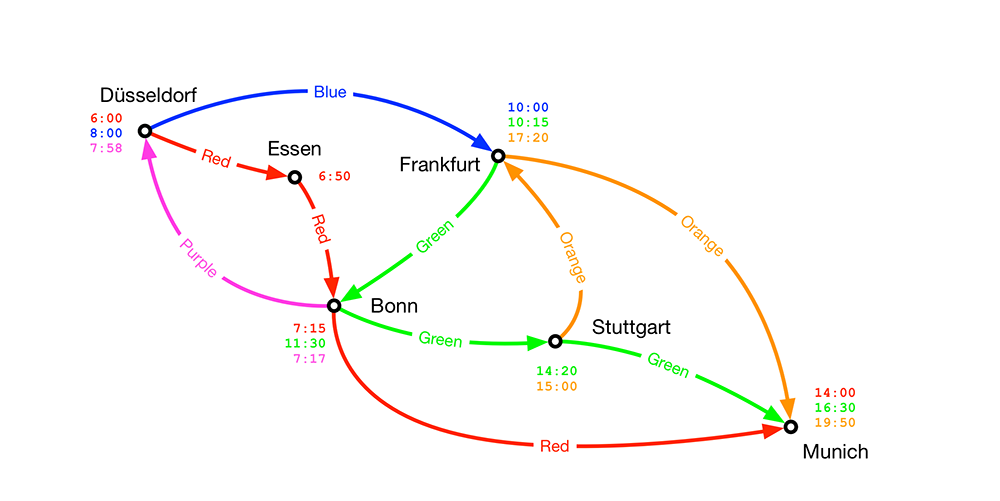-
In this exercise, you will implement an version of the
connectionsmethod that has the following properties:- It should perform the calculation asynchronously. Hence it will
return a
Future[Set[Seq[Hop]]] - It should, when present, exploit parallelism of the underlying compute infrastructure
- It should perform the calculation asynchronously. Hence it will
return a
Step by step instructions
-
Start from a copy of the non-tail recursive version of the
connectionsmethod -
Rename the method to
connectionsAsyncand define it to return an instance ofFuture[Set[Seq[Hop]]] -
What other change needs to be applied to the
connectionsmethod parameter list[s] in order to enable to utilisation ofFutures? -
Adapt the inner
connectionsmethod to take a single argumentsoFarFof typeFuture[Vector[Hop]]and that returns aFuture[Set[Vector[Hop]]] -
Start by adapting the code to do the first call to the inner
connectionsmethod:nextHops flatMap (hop => connections(Vector(hop))) -
Apply the "let-the-types-guide-you" principle:
- Look at the type of the elements you have and the type of what you need to produce
- You will run into the situation where the nested types are "in the wrong order"
Hints:
-
Future.sequencewill certainly be part of the solution -
Also consider applying
maporflatMap -
If you manage to adapt the code for the first call to the inner
connectionsmethod, you should be able to adapt the code in the inner method using the same principles -
You may need one extra step in the inner method to account for the fact that a
Futureis passed as an argument instead of a concrete value -
Use the
testcommand to verify the solution works as expected -
Use the
nextExercisecommand to move to the next exercise.
We have introduced concurrency in the implementation, but the question is, will this result in parallel execution of some of the concurrent tasks?
In order to find out, let's add some basic for of logging by adding a log
method in the JourneyPlanner source file using the following definition:
def log(msg: String): Unit = {
println(s"${System.currentTimeMillis()} - ${Thread.currentThread.getName}: $msg")
}Now add a logging statement in the inner (recursive) connections method like so:
log(s"connections: ${soFar}")Place this statement at a location so that it is invoked each time the inner connections method is called.
We could run the com.lightbend.training.scalatrain.JournalPlannerSpec, as this
runs the asynchronous implementation of the connections method. Problem though is
that, for other reasons, the testing system runs the tests on a single thread.
This can be verified by running the tests and observing that each invocation runs
on the same thread.
So, we need to write a small application that will execute the method.
Therefore, create a new Scala source file (AsyncConnectionsMain) and an object
with the same name that extends App.
Copy the test data object (exercises/src/test/scala/com/lightbend/training/scalatrain/TestData.scala)
into the new source file.
In object AsyncConnectionsMain, import TestData._.
Run the asynchronous connections method like so:
val connections = planner.connectionsAsync(dusseldorf, munich, Time(6,0))Note that you will need to provide an implicit ExecutionContext. The easiest way
to do this is to import scala.concurrent.ExecutionContext.Implicits.global.
Run the application and observe parallelism.
Congratulations: you have completed the course!
The single soFarF parameter to the inner connections method is a
Future[Vector[Hop]]. It is relatively straightforward to refactor the code so
that connections takes a Vector[Hop].
As a bonus exercise, do this refactoring and re-run the AsyncConnectionsMain
main program. What has changed? Can you explain what you observe?
Printing out the calculated connections in a readable format can be done using the
following helper method (defined in a companion object for the JourneyPlanner):
object JourneyPlanner {
def printConnections(connections: Set[Vector[Hop]]): String = {
val cs = for {
(connection, index) <- connections.to(Vector).zipWithIndex
hop <- connection
departureTime = hop.departureTime
arrivalTime = hop.arrivalTime
trainInfo = hop.trainInfo
from = hop.from
to = hop.to
} yield (index + 1, f"$trainInfo%30s - @ $departureTime: ${from.name}%-20s - @ $arrivalTime: ${to.name}%-20s")
val t = cs.groupMap(_._1)(line => line._2).to(Vector).sortBy(_._1)
val w = for {
(index, v) <- t
c = v.mkString("\n")
} yield s"\nConnection $index:\n$c"
w.mkString
}
}